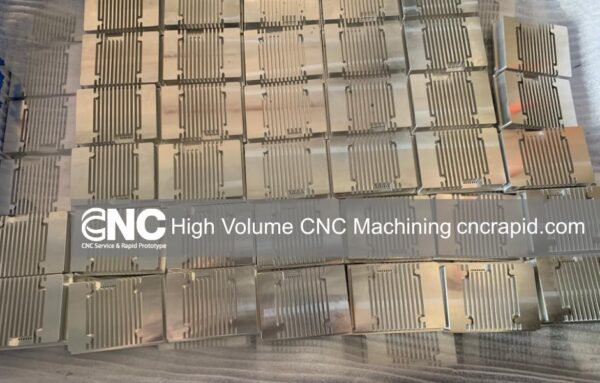High Volume CNC Machining. CNC machining is a manufacturing process in which pre-programmed computer software is used to control the movement and operation of machinery and tools. This allows for high levels of precision and repeatability in the production of parts and components. In recent years, CNC machining has become increasingly popular for high volume production, thanks to its ability to produce large quantities of parts quickly and accurately.
How do the CNC machines work?
CNC machines are automated, computer-controlled machines that are used for a variety of manufacturing processes, including milling, turning, and drilling. They are typically programmed using specialized software that allows the user to specify the desired shape and dimensions of the workpiece, as well as the cutting tools and machining operations that will be used to produce it.
The process of CNC machining involves the use of computer-controlled machinery and tools to shape and finish a workpiece. The process typically begins with the creation of a CAD (Computer-Aided Design) model of the part or component that is to be produced. This model is then used to generate the CNC machining instructions, which are typically written in a specialized programming language.
Our engineers use UG, a specialized CAD/CAM software, to create the program that will control the CNC machine. The UG program includes the precise instructions for the CNC machine to follow in order to shape the workpiece according to the desired specifications. This includes information about the cutting tools to be used, the machining operations to be performed, and the precise paths and speeds at which the tools will move. Once the program is complete, it is loaded into the CNC machine, and the machining process can begin.
Once the CNC machining instructions have been created, they are loaded into the CNC machine and the workpiece is securely attached to the machine. The machine then uses a variety of cutting tools, such as drills and endmills, to shape the workpiece according to the instructions. The tools are guided along precise paths and operated at specific speeds and depths to achieve the desired shape and finish.
During the CNC machining process, the machine’s controls and sensors can monitor the progress of the machining operation and make adjustments as needed to ensure that the workpiece is being produced according to the specifications. This allows for high levels of precision and repeatability in the production of parts and components.
After the machining process is complete, the workpiece is typically inspected to ensure that it meets the required specifications. Any necessary finishing operations, such as deburring or polishing, may also be performed. The finished part or component is then ready for use or further processing.
There are several key benefits of using CNC machining for high volume production, including:
- Consistency and accuracy: Because CNC machining is a highly automated process, it is able to consistently produce parts that meet precise specifications. This is particularly important in high volume production, where consistent quality is essential.
- Efficiency: CNC machining can be a very efficient way to produce large quantities of parts. Because the machining process is controlled by computer software, it can be easily optimized to maximize production speed and minimize downtime.
- Flexibility: CNC machining can be used to produce a wide range of different parts and components. By changing the CNC machining instructions, a single CNC machine can be used to produce many different types of parts, making it a flexible and versatile manufacturing technology.
- Cost-effectiveness: Despite its high level of precision and flexibility, CNC machining can be a cost-effective manufacturing process. Because the machining process is highly automated, it can be performed with relatively little labor, reducing production costs. Additionally, the high degree of precision and consistency in CNC-produced parts can reduce waste and scrap, further lowering costs.
High volume CNC machining is used in a wide range of industries, including automotive, aerospace, defense, medical, and consumer goods. In general, any industry that requires the production of large quantities of parts and components with high levels of precision and consistency is a potential user of CNC machining.
For example, the automotive industry uses CNC machining to produce a variety of parts and components, such as engine blocks, transmission components, and suspension parts. The aerospace industry also relies heavily on CNC machining, as it is used to produce parts for aircraft and spacecraft, such as fuselage panels, wing spars, and turbine blades.
Similarly, the medical industry uses CNC machining to produce a wide range of precision components, such as surgical instruments, dental implants, and prosthetic devices. And the consumer goods industry uses CNC machining to produce parts for a variety of products, including appliances, electronics, and sporting goods.
High volume CNC machining is a versatile and widely-used manufacturing technology that is suitable for many different industries.
CNC machining is typically used for medium to high volume production of metal and plastic parts and components. It is capable of producing large quantities of parts quickly and accurately and is often a more cost-effective choice for high volume production than injection molding or 3D printing.
At DFM Rapid, we are proud to offer high volume CNC machining services to our customers. Our CNC machines and experienced team of machinists are able to produce high quality parts and components in large quantities, quickly and accurately. We also offer a range of other manufacturing services, including prototyping, assembly, and finishing. Contact us today to learn more about how we can help with your high volume CNC machining needs.
Contact us
If you need Metal & Plastic parts machined for prototypes or production, please feel free to get a quote online.
Or email us at [email protected] to tell us About Your Project
Please try to include the following information:
- Part Name
- 3D Drawing
- Quantity
- Material
- Tolerance Range
- Surface Finish
Thank you for your time!












